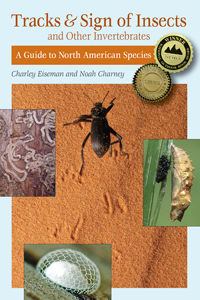Nine years ago this month, I published the first in a series of “monthly mystery” posts in which I wrote about nagging natural history mysteries with the hope that someone out there might have some answers, or at least suggest some possibilities I hadn’t thought of. That first mystery was the identity of these 3 mm long banana-shaped things Noah and I found stuck to pine needles at Yosemite National Park on July 26, 2008:
As I wrote before, “In photos, they look like they could be larvae, but they were hard and stationary and in person they gave the impression of eggs. There were often several in an evenly-spaced row, and all had tips that curved away from the substrate as shown [above].” One reader suggested that they looked like fly pupae, and another thought they might be tasty with lemon juice and cocktail sauce. No further progress was made until today, when I was scouring Middlekauff’s (1958)* publication on pamphiliid sawflies for every available detail about the natural history of the conifer-feeding species. In his notes under Acantholyda zappei, he wrote:
The pale yellow eggs are about 4 mm. long, tapered at each end and crescent-shaped. The shape is most unusual for a sawfly egg and in size may well be the largest known. . . The eggs are deposited singly, their long axis parallel to that of the [pine] needle, on new growth late in June and early July. When the young larvae hatch, they emerge from the end of the egg which tapers least and begin to spin a loose web around themselves, fastening the outer threads to the needles. . .
It had never crossed my mind that a sawfly could produce eggs that big—it seemed like they would have to be from something along the lines of a katydid or a walkingstick. But sure enough, a quick Google search turned up a fantastic photo of an Acantholyda larva hatching from a very similar egg in Finland.
Acantholyda zappei is restricted to the northeastern US and adjacent Canada (which means I should be able to find its eggs in my neck of the woods, though somehow I’ve never seen anything like those Yosemite bananas in the intervening 13 years), but there are 33 other Acantholyda species in the US and Canada, 14 of which occur in California. Some of those can be eliminated as possibilities because they feed on conifers other than pines, but several have never been associated with any host, and none of their eggs have been described, so the exact identity of the Yosemite eggs will remain a mystery for some time. In fact, the only other Acantholyda in North America whose eggs have been described is the “pine false webworm,” A. erythrocephala, which is a European species that was found in Pennsylvania in 1925 and has since spread at least to New Jersey and Ontario (and apparently Alberta). Here are some eggs I found in May 2011 on a white pine needle in Burlington, Vermont that are consistent with that species:

My only other encounter with this genus (that I know of!) is this adult of A. erythrocephala I photographed in Colchester, Vermont in May 2005:

* Middlekauff, Woodrow W. 1958. The North American sawflies of the genera Acantholyda, Cephalcia, and Neurotoma (Hymenoptera, Pamphiliidae). University of California Publications in Entomology 14: 51–174.




A gem of a bug..Beautiful.